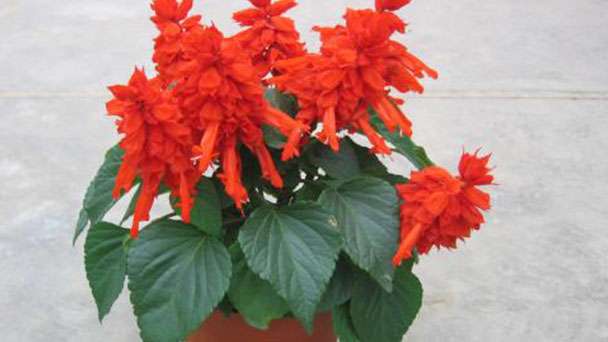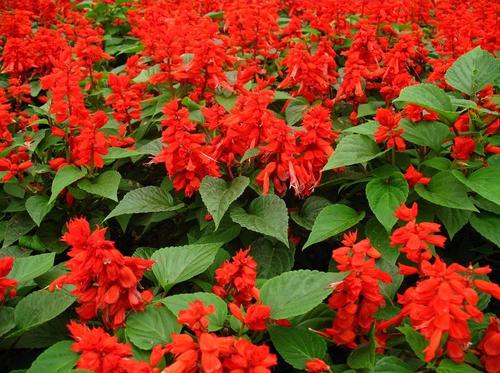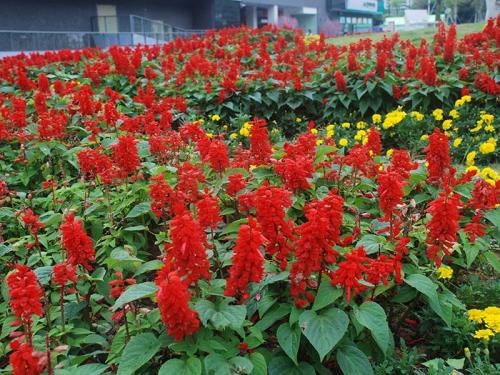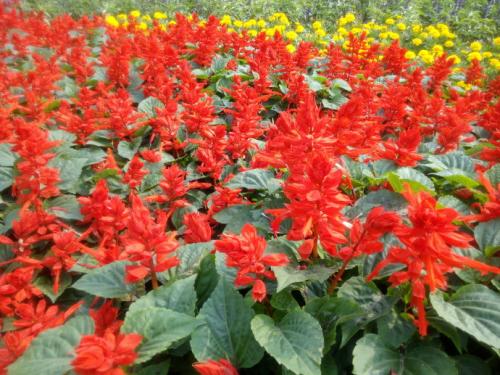Salvia splendens (Scarlet sage) profile
Written by Maggie
Oct 28 2021

Scarlet sage, also known as Salvia splendens, belongs to the genus Salvia of Labiaceae. Scarlet Sage has slender inflorescence, bright red color, long flowering period and strong adaptability. It is the most widely cultivated herbaceous flower in Chinese cities and gardens. In recent years, new developments have been made in the application of the ornamental plants of the genus Many new varieties of Sage safflower (red lip) and Sage calyx (a string of blue) have been developed. China has also introduced small batch production, in which the layout of urban landscapes has played a better effect.
Scarlet sage picture

Morphological characteristics of Scarlet sage
Rhizome
Scarlet sage is a sub shrubby herb, up to 90 cm high. Stem is obtuse, tetragonal, shallow groove, glabrous.
Leaf
Leaves of Scarlet sage is ovoid or triangular-ovoid, 2.5-7 cm long and 2-4.5 cm wide, apically acuminate, basally truncate or rounded, thinly obtuse, margin serrate, green above, lighter below, glabrous on both sides, masked glandular dots below; Cauline leaves of Scarlet sageare petiole 3-4.5 cm long, glabrous.
Flowers
Scarlet sage is a 2-6 - flowered cymbose with terminal racemes up to 20 cm long or more. Bracts are ovoid, red, large, enclosing bud before flowering, apex caudate-acuminate; Pedicels are 4-7 mm long, densely stained red glandular pilose, rachis puberulent. Calyx of Scarlet sage is bell, red, and the flowering time of about 1.6 cm, flowers after increases up to 2 cm, along the outside has been dyed red glandular villous on veins, inside the upper is slightly stiff hairs, lip, cleft lip 1/3 of calyx length, upper triangular ovoid, 5-6 mm long, 10 mm wide, apex with a small point, lower lip longer than upper lip slightly, deep cracks, 2 lobes triangular, apex acuminate.
Core
Corolla red Scarlet sage, 4-4.2 cm long, slightly pilose on outside, inside glabrous, crown tube tubular, straight, increases slightly in the throat, crown canopy two lip, upper lip straight, slightly concave, oblong, 8-9 mm long, ca. 4 mm wide, apex rounded emarginate, lower lip shorter than upper lip, 3 crack, lobes semicircular, lateral fissure long ovoid, than in the crack running time. Scarlet sage has 2 fertile stamens, proximal extensor, filaments about 5 mm long, septum about 1.3 cm long, nearly elongated, upper and lower arms nearly equal length, upper arm drug compartment developed, lower arm drug compartment sterile, lower arm thick, not united. Stamen of Scarlet sage is short. Style is subequal to corolla, apex unequal 2-lobed, anterior lobes longer. Disk is of equal size.
Fruit
Scarlet sage is a nutlet elliptic, ca. 3.5 mm long, dark brown, apex with irregular few ruffled protuberances, margins or edges narrowly winged, smooth.
Ecological habits of Scarlet sage
Scarlet Sage is sunny and tolerant to semi-shade, and requires loose, fertile and well-drained sandy loam. Scarlet sage is very sensitive to soil treated with methyl bromide and alkaline soil, and is suitable for growing in soil with pH5.5 -- 6.0.Cold resistance is poor, suitable for growth temperature 20-25 degrees Celsius. Under 15 degrees Celsius stop growing, 10 degrees Celsius below the leaf yellow falls off.
Growing methods of of Scarlet Sage
The planting distance of Scarlet Sage was about 40 cm, and the soil with rich humus or sandy soil was suitable. Scarlet sage grows in the busy season, can top dressing contain phosphorus liquid fertilizer 1 to 2 times, and make blossom luxuriant. Scarlet Sage does not like heavy water, otherwise it is prone to yellow leaves and deciduous leaves, resulting in large plants and sparse flowers. During growth, the heart should be plucked frequently to control plant height and branching. Make inflorescence long and fat, bloom neatly.
The spring sower blooms in autumn, and the old plants overwintering in the greenhouse also blooms in spring, but Scarlet sages are not as numerous as in summer and autumn. In summer the branches and leaves are vigorous, but the flowers are scarce. Scarlet Sage has a late flowering period. If it is to harvest seeds, it should be sown in greenhouses or hotbeds in early March. A little earlier flowering period is helpful for good fruiting. The seeds of Scarlet Sage were easy to fall, or could not mature fully because of the cool autumn, so they were often moved to a greenhouse for winter after pot planting. New branches were cut and cut for rooting in the second year, which was easy to take root.In the 15℃ above the hotbed, any period can be cuttings, inserted treaty 10 to 20 days to take root, 30 days can be divided planting. Cutting seedlings to the flowering period is faster than the seedling, plant height is easy to control. The late inserter Scarlet sage is short, although the growth potential is weak, but the effect on the flowering period is not big, the flowering is still luxurant, more convenient arrangement.For the purpose of seed collection, it is better to use seedlings. Scarlet Sage for National Day was cut in early summer, when the weather was hot and shading should be paid attention to, and rainproofing and drainage should be paid attention to when it was rainy.
Seedlings with 3 to 4 pairs of true leaves should be uprooted, each plant should have at least 4 lateral branches, and moved to the flower bed when the branch ends have shown color. Such as in front of the flower topdressing phosphate fertilizer, flowering is preferred. Scarlet Sage calyx faded over time and did not fall; for ornamental arrangement, it is necessary to remove the residual flowers at any time, to keep the color gorgeous.
Fertilization
Planting ground or potting soil all need to apply basal fertilizer.
Watering
In order to prevent barren growth of Scarlet sage, less water, frequently loose soil, and apply top dressing.
Temperature and illumination
The optimal growth temperature for Scarlet sage is 15-30 ℃, below 12℃ growth stagnation, leaves turn yellow, fall off, flowers gradually fall off.
The propagation mode of Scarlet Sage
Scarlet sage mainly to sow propagation, can also be used for cutting propagation. Sowing time can be carried out in spring (from late February to early March in Shanghai area). After sowing, soil is not needed and the temperature is kept at about 20°C. Germination can be achieved in about 12 days. Cuttage propagation can be carried out in summer and autumn (the color variation is larger, can sow in advance, the color, and then use cuttage propagation).
Seed propagation
Generally in spring sowing. Seeds larger, 1 gram of 260-280 seeds. The optimum temperature for germination was 21 -- 23℃, and 15 -- 18 days after sowing. If autumn sowing can be used indoor disc sowing, the room temperature must be above 21℃, rapid and neat germination. When the temperature is lower than 20℃, the germination potential decreases obviously. In addition, Scarlet Sage is a light-happy seed, which does not need to be covered with soil after sowing. Light vermiculite can be used to put around the seeds, which does not affect light transmittance and has a moisturizing effect, and can improve the germination rate and uniformity, with the general germination rate reaching 85%-90%.
Cutting propagation
Spring to summer is the best. Choose strong and substantial branches, 10 cm long, inserted into disinfected leaf soil, soil inserted to maintain 20℃, 10 days after insertion can take root, 20 days can be transplanted.

Disease and pest control of Scarlet sage
Black rot
Black rot mainly encroaches on Scarlet sage leaves, petioles and tender shoots. At the beginning of leaf onset, purple brown to brown spots appear on the front. After enlargement, they are mostly round or amorphous black brown spots.Can spray carbendazim, methyl tobujin, dakonin and other drugs.
Powdery mildew
Powdery mildew Injury young leaves of Powdery mildew, both sides appear white powdery matter, early symptoms are not obvious, the white powder layer appears 3-5 days later, the leaves were watermark, gradually lose green turn yellow, serious injury in the cause of leaf shedding. The onset period is sprayed with polymycelium, triazole ketone can, but the best effect with the country light Yingna.
Leaf blight
Most of the leaf tip or leaf edge invasion, the initial yellow dot, then rapidly expanded to the inward irregular shape of the large spot, seriously damaged whole leaf dry up to 2/3, the disease of the greenish yellow, brown dry off. In addition to strengthening fertilizer and water management, in winter, diseased branches and diseased leaves of Powdery mildew should be cut off, underground leaves should be removed, and the source of initial invasion should be reduced. When the disease occurs, comprehensive control should be taken, and carbendazim, methyl tobutazin and other bactericidal agents should be sprayed.
Disease is mainly given priority to by prevention, in high temperature, high humidity or rainy season regularly spray antiseptic drugs, in the dormant stage of the seedlings into the spray of sulphur mixture for comprehensive sterilization, ensure robust growth of seedlings, seedlings grow strong, itself resisted certain disease invasion.
Pest control
Thorn moth
They mainly feed on leaves of Powdery mildew in high temperature seasons. They are mainly the larvae of Lepidoptera flavescens, Lepidoptera flavescens, Lepidoptera flavescens, Lepidoptera flavescens and Lepidoptera flavescens.
Method of prevention and cure
Once found, it should be immediately sprayed with 90% trichlorfon crystal 800 times solution or 2.5% methothrin emulsion 15 00 times solution.
Scale insects
There are mainly white rostra scale, Japanese tortoise wax scale, red wax scale, brown soft wax scale, blowing cotton scale, chaff plate shield scale, snake eye scale, etc., which is characterized by sucking juice of tender stem and young leaves of Scarlet Sage, leading to poor plant growth, mainly caused by high temperature, high humidity, poor ventilation and poor light.
Method of prevention and cure
It can be used to kill the nymphs at the peak of their hatching period by spraying with 25% of the WP 2 000 times liquid.
Sphids
The main species were the scarlet sage tube aphid, peach aphid, etc., which punctures the juice of the tender organs of the plants, harms the tender stems, young leaves, and flower buds, and seriously affects the growth and flowering of the plants.
Method of prevention and cure
Spray with 10% imidacloprid wettable powder 2000 times liquid in time.
The rosebush tricarpate wasp
More in the larval stage, dozens or hundreds of clusters of harm, in a short time can eat up the tender leaves of the plant, leaving only a few main veins, serious harm to the normal growth of the plant.
Method of prevention and cure
A small number of potted plants, can be at the beginning of the appearance of the gathering of a large number of larva leaves, trampled to death. A large number of available 75% phoxim emulsion 4000 times liquid spray kill.
Vermilion leaf mites
It can occur for 10 to 15 generations a year. Most of the eggs are produced on both sides of the back veins of the leaves or under the filament net if the adults, juveniles and mites gather in the back of the leaves.Each female mite can lay 50 to 150 eggs, up to 500 eggs at most. It takes only 10 to 13 days to complete the generation under the temperature of 23℃ to 25℃, and about 7 to 8 days under the temperature of 28℃.Rampant in high temperature and drought season, often lead to a large number of dense small white spots on the front of the leaf, leaf back yellow and even with dry spots.
Method of prevention and cure
Once found, use 25% Beileba WP 2000 times liquid spray kill.
The beetle.
Mainly for verdant scarab, black velvet scarab, white star flower scarab, small blue and white scarab, often with adult insects gnaw feed new leaves, tender tip and bud, seriously affect the growth of the plant and flowering.
Method of prevention and cure
Using the false mortality of the adult insect, it is killed in the evening. The phototaxis of the adults were used to trap and kill them with black light.When feeding on adult pests, use 50% malathion emulsion 1000 times liquid spray to kill. In addition, there are other pests such as lampmoth, noctua moth, bridgeworm, pouched moth, leaf cicada, and stink bug, etc., and corresponding control measures can be taken according to the harm characteristics of different pests.
Distribution region of Scarlet sage
Scarlet Sage originated from Brazil and has been widely cultivated in China.
Function and use of Scarlet sage
Scarlet sage can be door potting, flower bed flowers, flower viewing classes, flower beds, flower belts, potted plants
Scarlet sage flower language
Scarlet sage represents the heart of love, a string of white represents vigor, and a string of purple represents wisdom.

Read Next:
Top 10 Most Beautiful Roses in the World
Top 10 Most Beautiful Flowers in the World
26 Best Autumn Flowers to Plant for Fall Color in Garden
Latest Updated
- Benefits of Bugleweed - 7 Science-backed Health Benefits
- Bugleweed Dangers & Side Effects - Is It Poisonous?
- How to Plant Evergreen Trees - What You Should Know
- When to Plant Evergreens - Grow Guide for Evergreen Trees
- 12 Wonderful Evergreen Shrubs for Your Garden
- 12 Popular Evergreen Plants with Pictures for Beginners
- When And How To Prune A Lilac Bush Like a Pro
- How to Grow & Care for Lilac Vine (Hardenbergia Violacea)
- Japanese Lilac Tree (Syringa Reticulata) Care & Propagation Guide
- Shumard Oak Pros and Cons - What to Know
Popular Articles
- Winter maintenance of Antirrhinum Majus
- How to Grow Terminalia Mantaly Tree
- How to Grow and Care for Crossostephium Chinense
- How to grow Antirrhinum Majus in spring
- Peristeria Elata (Dove Orchid) Profile: Info & Care Guide
- Underwatered Snake Plant (Sansevieria Trifasciata) - Signs And How To Fix
- How to Care for Brazilian Jasmine Plant (Mandevilla Sanderi)
- How to Grow & Care for Graptopetalum Purple Delight in Summer
- Rosa Chinensis (China Rose): Plant Growing & Care Tips
- How to Care for Baby Sun Rose (Aptenia Cordifolia)